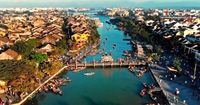Vietnam has emerged as a remarkable player in the global tourism landscape, ranking seventh worldwide in tourism growth, according to data from Google Destination Insights. The country has seen a significant increase in international interest, with searches for travel to Vietnam rising between 10% and 25% since the beginning of 2025. This growth positions Vietnam as the sole Southeast Asian destination in the top ten, far outpacing its regional competitors.
The National Tourism Administration of Vietnam highlighted that the most searched cities by international tourists include Ho Chi Minh City, Hanoi, Da Nang, Phu Quoc, Nha Trang, Hoi An, Vung Tau, Da Lat, Phan Thiet, and Hue. Notably, the leading markets driving this interest are the USA, India, Australia, Japan, Singapore, South Korea, the UK, Taiwan (China), Malaysia, and Hong Kong (China).
According to the National Tourism Administration, Vietnam's appeal as a tourist destination stems from its diverse and attractive offerings, ranging from cultural and natural tourism to beach resorts and urban experiences. The country's tourism infrastructure has been steadily modernized, with improved transportation systems connecting air, road, and sea travel. Additionally, the increasingly liberal visa and immigration policies have significantly enhanced Vietnam's image on the global tourism map.
As Vietnam enters the peak season for beach tourism in 2025, the demand for travel services and goods at tourist destinations is on the rise. From April 30 to May 2, 2025, the World Heritage Site of Ho Dynasty Citadel welcomed approximately 10,000 visitors, averaging over 3,000 daily, which is double the number from the same period last year. This surge in tourism reflects the growing interest in Vietnam as a travel destination.
Furthermore, data from Agoda indicates that searches for accommodations in Vietnam from European tourists surged by 66% in April 2024 compared to the previous year. This growth has positioned Vietnam as the third fastest-growing destination in Asia for European travelers, trailing only behind Malaysia and Japan. France, Germany, the UK, the Netherlands, and Spain are leading the charge in terms of interest and tour bookings.
The most favored destinations among European tourists include Ho Chi Minh City, Hoi An, and Nha Trang, which offer a harmonious blend of relaxation, cultural exploration, and unique culinary experiences. Nguyen Minh Man, Communications Director at TST Tourist, noted that European travelers are not looking for short experiences; they seek longer, high-quality journeys that provide deep cultural engagement. This segment of tourists tends to spend more, presenting a valuable opportunity for Vietnam if approached correctly.
To facilitate this influx, Vietnam has extended its unilateral visa exemption period to 45 days for citizens of several European countries since August 15, 2023, and has broadened the application of e-visa policies. These changes have significantly boosted the number of visitors from this market, contributing to a total of over 4.6 million international arrivals in the first quarter of 2024.
Tran Trong Kien, Chairman of the National Tourism Advisory Board, emphasized that simplifying entry procedures is crucial for Vietnam to compete with Thailand, Indonesia, and Malaysia in attracting European tourists. In response to the growing interest, many businesses are proactively designing long-term travel products that focus on sustainable experiences, high-end relaxation, and local exploration. Tours lasting between 8 to 14 days connect various destinations like Hanoi, Ha Long, Hue, Hoi An, Ho Chi Minh City, and Can Tho, often including stays in Phu Quoc or Nha Trang.
Le Thi Thanh Thuy, CEO of Indochina Voyages, shared that they prioritize custom tours for European clients, focusing on services rated four stars or higher, employing French or German-speaking guides, and incorporating activities like cooking classes, kayaking, and visits to traditional markets. This approach caters to travelers' keen interest in local cultural life.
Moreover, major travel companies such as Saigontourist, Vietravel, and Fiditour are actively participating in international trade fairs in Berlin, Paris, and Milan to promote Vietnam's tourism image. Many businesses have also signed partnerships with leading European travel agencies like Studiosus Reisen (Germany) and Kuoni Global Travel Services (Switzerland) to enhance tour offerings for Vietnam in the summer of 2024.
Tourism has been strategically identified as a key economic sector since the issuance of Resolution 08-NQ/TW by the Politburo in 2017. The government aims for tourism to contribute 12-14% of GDP by 2030. In 2023, total revenue from tourism reached approximately 678 trillion VND, equivalent to 5.5% of GDP, providing direct and indirect employment for over 4 million workers.
Notably, European tourists are recognized for their higher spending and longer stays, which are seen as vital for increasing revenue and enhancing the quality of Vietnam's tourism. Additionally, tourism plays a significant role in fostering economic development in rural and mountainous areas rich in natural and cultural resources.
Vu The Binh, Chairman of the Vietnam Tourism Association, stressed that focusing on developing the European market is a smart strategy. While European travelers may be quieter, they bring substantial revenue, strong brand value, and are instrumental in promoting sustainable development.
To capitalize on these opportunities, Vietnam’s tourism sector must continue investing in infrastructure, improving service quality, and safeguarding the environment. It is essential to create favorable conditions for small and medium enterprises to participate in the service supply chain, including homestays, restaurants, transportation, and guiding services, aligning with international standards.
Additionally, the digital transformation in management, sales, and promotion is becoming an inevitable trend. Companies like Lux Group and Vidotour have begun implementing digital tools for virtual tours and online interactions to effectively reach European customers. Recently, at the Salone Dei Tessuti Exhibition Center in Milan, Vietnam Airlines officially launched a direct flight connecting Hanoi and Milan. This event is part of the Vietnam-Europe Tourism Promotion Program, opening up significant opportunities to strengthen tourism and economic cooperation between Vietnam and Italy.
With open policies, proactive business engagement, and clear strategic direction from the government, Vietnam is poised to affirm its position on the international tourism map. While the European market may be challenging to penetrate, if effectively tapped, it could provide a stable source of income, helping Vietnam's tourism sector truly become a key economic driver in the coming years.




